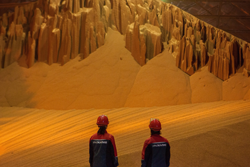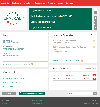Uralkali Announces IFRS 1H 2015 Financial Results

Uralkali (LSE: URKA; the Company), one of the world’s largest potash producers, announces its financial results for the six months ended 30 June 2015 prepared in accordance with IFRS1.
1H 2015 financial highlights:
- Revenue down 9% y-o-y to US$ 1,562 million
- Net revenue2 down 1% y-o-y to US$ 1,309 million
- EBITDA3 up 22% y-o-y to US$ 933 million
- EBITDA margin4 up to 71%
- Net profit up 50% y-o-y to US$ 556 million
- Cash COGS down 35% to US$ 33 per tonne
- Average FCA export price up 10% to US$ 242 per tonne of KCl
1H 2015 operational highlights:
- Production down 6% y-o-y to 5.7 million tonnes of potassium chloride (KCl)
- Sales volumes down 7% y-o-y to 5.6 million tonnes of KCl
Corporate highlights:
- In March, Uralkaliís Board of Directors approved a revised Development Strategy for
2015-2020 as a result of a strategic review following the Solikamsk-2 accident. The updated programme is focused on capital intensive investment in the Companyís production facilities in order to sustain Uralkaliís industry leadership. Total capital expenditure will amount to approximately RUB 300 billion between 2015 and 2020 - In April, Uralkali signed a US$ 530 million
4-year Pre-Export Facility with the option to increase the amount up to US$ 800 million. In June, the amount of the facility increased to US$ 655 million - In April, the Board of Directors adopted a new discretionary dividend policy providing flexibility to the Board of Directors in determining the amount of dividend payments
- In April-June, Uralkali executed a tender offer for its shares and GDRs, purchasing 11.56% of Uralkaliís outstanding common shares for a total amount of US$ 1.09 billion
Significant events after the reporting period:
- In August, the Moscow Exchange registered Uralkaliís Exchange Traded Bonds Programme of up to RUB 100 billion
- In August, Uralkali entered into an agreement to acquire 20,358,852 shares of additional issuance of JSC Uralkali-Technology, a wholly-owned subsidiary of the Company, for a total amount of approximately RUB 145 billion, which was approved on 7 August 2015 by Extraordinary General Shareholders Meeting of the Company. On 11 August 2015 Uralkali transferred the first payment of approximately RUB 90.2 billion to JSC Uralkali-Technology, which was used to pay the debt of JSC Uralkali-Technology to PJSC Uralkali. The remaining shares of JSC Uralkali-Technology will be paid on 25 August 2015. The funds will be used to acquire Uralkali GDRs from Enterpro Services Limited. As a result, JSC Uralkali-Technology will hold quasi-treasury shares and GDRs representing 24.2% of the share capital of PJSC Uralkali.
Dmitry Osipov, Uralkali CEO, commented:
In 1H 2015, the potash market faced the twin challenges of a tough agricultural environment and inventory drawdown after a solid buildup last year. Modest demand and strong competition among suppliers put pressure on the prices in the spot markets in 2Q 2015. Challenging market together with decreased Uralkaliís capacity resulted in lower sales and revenue volumes for Uralkali. However, rouble depreciation against 1H 2014 enabled the company to increase its net profit for the first half of the year to US$ 556 million.
Following the accident at Solikamsk-2, Uralkali has focused on undertaking its 300 billion rouble capacity development programme with the stated aim of a capacity of 14.4 million tonnes of potash per year from 2020 and safeguarding the Companyís leading market position in the long term.
The key 1H 2015 operational and financial metrics are as follows:
|
1H 2015 |
1H 2014 | |
|
Revenue (US$ million) |
1,562 |
1,726 |
|
Net revenue (US$ million) |
1,309 |
1,316 |
|
EBITDA (US$ million) |
933 |
767 |
|
EBITDA margin |
71% |
58% |
|
Net profit (US$ million) |
556 |
370 |
|
Average export potash price, FCA, US$ |
242 |
220 |
|
Production (KCl, million tonnes) |
5.7 |
6.0 |
|
Sales volume (KCl, million tonnes) TOTAL — Domestic ó Export |
5.6 1.0 4.6 |
6.1 1.0 5.1 |
Financial Review
In 1H 2015 the moderate demand and Uralkaliís decreased capacities resulted in lower sales volumes year-on-year of 5.6 million tonnes of KCl, and a 9% decrease in revenue year-on-year. However, significant rouble depreciation contributed to low cash COGS of US$ 33 per tonne and an average export price of US$ 242 per tonne, a 10% rise year-on-year, which provided for the net profit of US$ 556 million.
Following the net loss for 2014, Uralkaliís Annual Meeting of Shareholders decided not to pay dividends for 2014.
Uralkali's Board of Directors decided to use its cash reserves to return funds to shareholders through the purchase of shares and GDRs. The tender offer was effected between 24 April 2015 and 11 June 2015 and resulted in purchase of securities constituting in aggregate approximately 11.56% of Uralkaliís outstanding common shares. In August, Uralkali entered into an agreement to acquire 20,358,852 shares of additional issuance of JSC Uralkali-Technology, a wholly-owned subsidiary of the Company, for a total amount of approximately RUB 145 billion, which was approved on 7 August 2015 by Extraordinary General Shareholders Meeting of the Company. On 11 August 2015 Uralkali transferred the first payment of approximately RUB 90.2 billion to JSC Uralkali-Technology, which was used to pay the debt of JSC Uralkali-Technology to PJSC Uralkali. The remaining shares of JSC Uralkali-Technology will be paid on 25 August 2015. The funds will be used to acquire Uralkali GDRs from Enterpro Services Limited. As a result, JSC Uralkali-Technology will hold quasi-treasury shares and GDRs representing 24.2% of the share capital of PJSC Uralkali.
In April, the Companyís Board of Directors adopted a new, discretionary dividend policy which provides that the Board of Directors will determine the amount of dividend payments.
The company continued to work on its loan portfolio. In April, Uralkali signed a US$530 million
At the end of June 2015, the Companyís net debt amounted to US$ 3,528 million, net debt\LTM EBITDA ó 1.8x. The average interest rate across the portfolio was above 4%.
Business Review
As a result of decreased capacities following the accident at Solikamsk-2 mine in November 2014 and moderate demand in 1H 2015 the output declined by 6% year-on-year to 5.7 million tonnes of KCl.
Uralkali continues to implement the plan to address the consequences of the accident and mitigate the potential negative impact. The Company is pumping out brine from the inflow area, proceeding with works to strengthen the cut-off walls between the Solikamsk-1 and Solikamsk-2 fields, and is tamping the water channels in the water-blocking layer. As of 24 August 2015, the sinkhole was measured 122 by 125 metres at the surface. In addition, Uralkali backfills the worked-out areas of the mine using hydraulic methods to reduce rock mass deformation. The average brine inflow for the last ten days amounted to 310†cubic metres per hour.
The RUB 300 billion investment programme is in progress and aims to achieve production capacity of 14.4 million tonnes of KCl in 2020:
- Uralkali has completed the expansion of load capacity at Berezniki-3, and load capacity expansion at Berezniki-4 is in progress. The two upgrades together will enable the Company to increase KCl output capacity by 0.8 million tonnes from 2016
- Uralkali started preparatory works to complete the construction of a new shaft at Solikamsk-3, that will enable it to produce additional 0.6 million tonnes of KCl annually starting from 2017
- At the Ust-Yayvinsky mine the shafts are being reinforced with tubbing, project documentation for above-ground infrastructure has been approved and subcontractor tender has been launched to start production in 2020
- Uralkali is carrying out design engineering works for the construction of the new mine at Solikamsk-2 and at the Polovodovo mine field
- Preparatory works to develop granular capacity at Berezniki-3 and Solikamsk-3 are on track
Market Outlook
The potash market was relatively weak in 1H 2015. Volumes remained under pressure in major spot markets due to the tough agriculture environment and inventory drawdown after a solid buildup last year. Pricing trended negatively throughout 1H 2015 in spot markets on the back of lackluster demand and strong competition among suppliers.
In China, potash suppliers continue to deliver volumes according to 2015 contracts. Chinese fertiliser VAT introduction along with Yuan depreciation may negatively impact import volumes this year.
In India, shipments from FY 2015/16 contracts continue to arrive at the ports. In January-July 2015, India imported 2.3 million tonnes of KCl, an increase of 9% compared to the corresponding period last year. The depreciation of the Indian rupee against the US dollar, subsidy issue, and the monsoon deficit may affect importers and may influence the full-year potash import figure. India is expected to import
Demand in Southeast Asia & Oceania was relatively strong while the competition among suppliers was strong in 1H 2015. Southeast Asia is currently out of buying season. Demand is expected to return by late September/October. The upside to potash demand in the region is limited due to local currency weakness, low palm oil prices, and competitive pricing from suppliers. The region is expected to import
In Latin America, tight credit availability in Brazil, weak crop prices, currency volatility against US dollar and inventory destocking were forcing down farmer demand in the region and causing a drop in potash prices amid strong competition in the region. In the first six months of 2015, Brazilian potash imports fell 21% y-o-y to 3.2 million tonnes. Potash demand in the region is expected to fall to
EMEA potash demand is expected to decline to
In Russia, potash consumption declined y-o-y in 1H 2015 due to deferred demand as prices increased y-o-y following the rouble devaluation.
In North America, potash demand in the first half of 2015 is estimated to have been below average mainly due to delayed planting season, high potash price volatility because of strong competition, and lower corn planted acreage. The upside to potash demand in 2H 2015 is limited due to crop price environment. North American potash demand is expected to decline by
The Company expects global potash demand to be down in 2015 to 58 million tonnes from 63 million tonnes in 2014, reflecting industry destocking and lower grain price environment.
Uralkali (www.uralkali.com) is one of the worldís largest potash producers and exporters. The Companyís assets consist of 5 mines and 7 ore-treatment mills situated in the towns of Berezniki and Solikamsk (Perm Region, Russia). Uralkali employs ca. 11,000 people (in the main production unit). Uralkaliís shares and GDRs are traded on the Moscow Exchange and London Stock Exchange, respectively.
1 Financial statements are reviewed by ZAO Deloitte & Touche CIS and can be found on Uralkaliís website http://www.uralkali.com/investors/reporting_and_disclosure/uk_msfo/
2 Net Revenue is revenue net of freight, railway tariff and transshipment cost
3 EBITDA is calculated as Operating Profit plus depreciation and amortisation
4 EBITDA margin is calculated as EBITDA divided by Net Revenue


